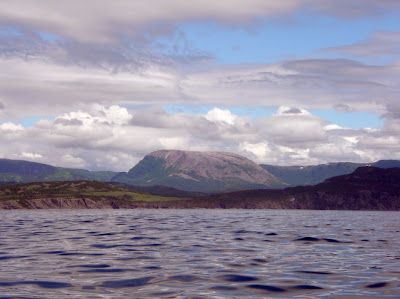
Once you paddle out of Burgeo, the urge to continue along the coast is almost overwhelming. The rugged shore line disappears into the distance ahead of you. Headland after headland, the treeless, barren hills, cliff-lined inlets, spray clad islands and the never-ending rhythm of the sea all conspire to lure you on. Trapped by its powerful pull, I tried to slip through a tiny gap leading from Bay de Loup into the next bay to the east. This break in the hills would save me several additional kilometers of paddling out and around the headland. As I approached the narrows and entered its confines, I could see the swell breaking in the rocky shallows at the narrowest point. With the timing of the in-coming swell different on each side of the gap, the surf that resulted was a bit too confused for my 'rock-garden' skill level to manage. I tried to catch the effect in the picture above, but the shutter delay conspired against me. All looks calm above, but a trap awaited...
I backed out of the channel until it widened enough to turn around. I'm just not a rock garden paddler, at least not yet! Perhaps had the tide been higher, the chances of getting through unscathed would have been better. Perhaps had I not been alone, I would have dared it. It beckoned so strongly, but then again, its timing looked tricky...

There was so much more to explore in the area. I headed several kilometers up the Bay de Loup inlet until I could see its head. Cabins dotted the shore. The bare rock hillsides were a geologist's dream, both in their formation and subsequent glaciation and weathering. In places, trees clung stubbornly to the slopes, somehow managing to live in such precarious a place.
The longer I stayed out, the more the weather continued to deteriorate. The clouds kept dropping lower and finally the rain began. Patches of fog started drifting here and there as the wind rose from off the sea to the south. It was time to break the spell, turn around and retreat back to Burgeo. Certainly the temptation to keep on going eastwards along the southern shore was strong. It's a fascinating place to paddle with so much to explore and enjoy, in spite of the reputation it has for foul weather. It's easy to feel the draw it has on you, urging you to keep paddling, to keep exploring. Time slowly disappears, responsibilities vanish into the fog... Paddling becomes everything.


























